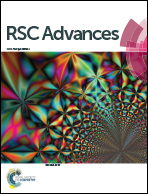Rational design and preparation of few-layered MoSe2 nanosheet@C/TiO2 nanobelt heterostructures with superior lithium storage performance†
Abstract
A heterostructure of MoSe2 nanosheets decorated on C/TiO2 nanobelts was successfully fabricated through a facile hydrothermal process with the assistance of glucose. Ultrathin MoSe2 nanosheets fully covered on TiO2 nanobelts were coupled with carbon components as strong skeletons, which possess high contact surface area, efficient electronic transport frameworks and sufficient void spaces. As expected, the MoSe2@C/TiO2 heterostructures exhibit remarkable cycling stability (discharge capacity of 987.4 mA h g−1 after 100 cycles at a current density of 500 mA g−1) and rate capability (retained capacity of 860 mA h g−1 even at a current rate of 3000 mA g−1) as anode materials in lithium-ion batteries. The excellent electrochemical performance can be attributed to the structural advantages of MoSe2@C/TiO2 heterostructures, enabling great potential as anode materials in lithium-ion batteries.



 Please wait while we load your content...
Please wait while we load your content...